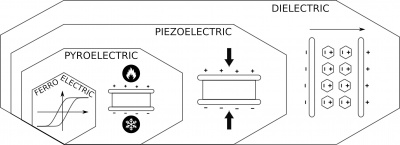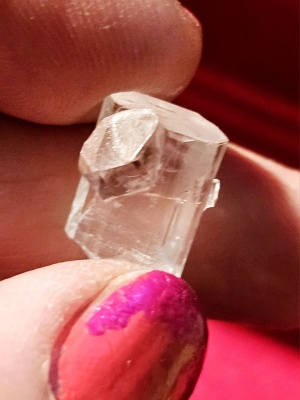Difference between revisions of "EnergyCrystals"
(→Hearing the crystals with a NanoAmp) |
(→Hearing the crystals with a NanoAmp) |
||
| Line 64: | Line 64: | ||
The electric charges created by a piezoelectric crystal can be heard through an audio amplifier. With the NanoAmp by the Swiss Mechatronic Art Society (SGMK) we could hear vibrations on our self grown Rochel Salt Crystals. With two electrodes applied to the crystals and attached to the imput of the amplifier, tapping on the crystal can be clearly heard through a headphone. Even just scratching the crystals with one input lead while holding the other one to the crystal, scratchy sounds appear. This method can also be used to distinguish crystals made from piezoelectric and non-piezoelectric materials (such as alum crystals) | The electric charges created by a piezoelectric crystal can be heard through an audio amplifier. With the NanoAmp by the Swiss Mechatronic Art Society (SGMK) we could hear vibrations on our self grown Rochel Salt Crystals. With two electrodes applied to the crystals and attached to the imput of the amplifier, tapping on the crystal can be clearly heard through a headphone. Even just scratching the crystals with one input lead while holding the other one to the crystal, scratchy sounds appear. This method can also be used to distinguish crystals made from piezoelectric and non-piezoelectric materials (such as alum crystals) | ||
| + | |||
| + | [[:File:NanoAmp_MakeAway.pdf]] | ||
== Measuring with a Charge Amplifier == | == Measuring with a Charge Amplifier == | ||
Revision as of 19:21, 5 December 2023
This page is to summarize our research in electro active crystal materials. There are many great instructions and descriptions online. The purpose of this summary is to give an overview of what we looked into and interesting insights we found. For detailed step by step instructions follow the links.
There are different electro active effects in crystal materials and those effects can be viewed in an onion hierarchy in some materials cumulate multiple effects.
Contents
- 1 Dielectric Effect
- 2 Piezoelectric Effect
- 3 Pyroelectric Effect
- 4 Ferroelectric Effect
- 5 Make Rochelle Salt Crystals
- 6 Hearing the crystals with a NanoAmp
- 7 Measuring with a Charge Amplifier
- 8 Storing charge on a Rochelle Salt crystal
- 9 Making Amorphous Crystals
- 10 Sparkles on commercial piezo element
Dielectric Effect
The most basic effect is the dielectric effect. When an electric field is applied by placing electrodes on two surfaces of crystals and applying an electric voltage, the crystal polarizes (dielectric polarisation). This means, while the crystals are electrically isolating materials and no current can flow through, in dielectric materials, charges can still shift slightly towards the poles.
What is this good for? Don't know, it's just the effect highest in hierarchy.
Piezoelectric Effect
Much more interesting is piezoelectric effect, the next in the hierarchy. All piezoelectric materials are also dielectric materials (while not all dielectric materials are also piezoelectric). A piezoelectric material has a special internal charge distribution such that when a mechanical force or vibration is applied it generates a polarization. So when the piezoelectric crystal with two conducive surfaces is put under mechanical stress it generates and electric voltage. This effect is reversible, so when an electric voltage is applied the crystal may deform.
Pyroelectric Effect
It get's even more fancy with the pyroelectric effect where a change in temperature can create an electric charge. And again, every pyroelectric crystal is also piezoelectric and dielectric.
We have not gone into this effect much yet.
Ferroelectric Effect
Deepest down in the amazing electro active effects of crystals materials are the ferroelectric materials. If you find those you are lucky, they combine all the previous effects, plus they can keep their electric polarization even when the applied voltage is removed. So by that effect the crystals can be "programmed" to store information. Yes, see the experiments described below.
By the way, already Pierre and Jacques Curie experimented with the piezoelectric effect and found that quartz and Rochelle salt display the strongest piezoelectricity. But this time they were not the first to discover the effect itself it was discovered in 1824 by David Brewster.
Today we know that even onion skin, DNA, phages and maybe even candy floss made from cane sugar shows piezzoelectric effects.
Make Rochelle Salt Crystals
Making crystals is easy and fun. An easy way to grow nice crystals is with Potassium alum. All ready the ancient Egyptians used it to make crystals. However while Potassium alum is dielectric, it is not piezoelectric.
An easy to grow crystal that shows all the amazing electro active properties is Rochelle Salt crystal. Also know as Sodium Potassium Tartrate Tetrahydrate, the crystals can be grown with common kitchen ingredients. All you need is washing soda (sodium carbonate), cream of tartar (potassium bitartrate or potassium hydrogen tartrate), and water. If you don't find washing soda you can make it from baking soda. See instructions blow.
Here just our learnings form spending hours of trying to make big and perfect crystals:
- While there are slightly different recipes, the ratio of water and cream of tartar should be somewhere between 1.25x and 1.38
- The ratio between cream of tartar and sodium carbonate is about 3.8x but this is not so important as you just add as much soda until it stops fizzling
- Yes, adding sodium slowly seems to be important, especially towards the end
- The solubility changes a lot with the temperature. So make sure you are at about 70°C
- The crystals start forming as the solution cools down. If the concentration is too high crystals form too quickly and you get just many small crystals
- If the concentration is too low the seed crystals dissolve before they start to grow. So getting the concentration right is important.
- Rochelle Salt crystals dissolve easily in water. So if you are not happy with what you get, a good way is to just dissolve the Rochelle Salt again and make it crystallize again.
- Seed crystals are an art on it's own. Suspend a perfectly formed seed crystal in the cooled down solution to grow big and perfect crystals.
- To attach seed crystals to a wire a good method we found is to heat a thin cooper wire and stick it into the crystal (by locally melting it)
- Yes, Rochelle Salt Crystals have a very low melting point of about 75°C
- The low melting property can be used to easily make multi-crystalline materials
- Sodium hydroxide (NaOH) can be used instead of Washing soda
- The Rochelle Salt Crystals have a very distinct crystal shape. You see it if you grow a perfect crystal
- The different electric effects vary with the face of the crystal you apply the electrodes to
Links: https://www.instructables.com/Make-Rochelle-Salt/ https://sciencenotes.org/how-to-make-rochelle-salt-sodium-potassium-tartrate-tetrahydrate/ https://en.wikipedia.org/wiki/Potassium_bitartrate
Hearing the crystals with a NanoAmp
The electric charges created by a piezoelectric crystal can be heard through an audio amplifier. With the NanoAmp by the Swiss Mechatronic Art Society (SGMK) we could hear vibrations on our self grown Rochel Salt Crystals. With two electrodes applied to the crystals and attached to the imput of the amplifier, tapping on the crystal can be clearly heard through a headphone. Even just scratching the crystals with one input lead while holding the other one to the crystal, scratchy sounds appear. This method can also be used to distinguish crystals made from piezoelectric and non-piezoelectric materials (such as alum crystals)

